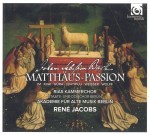 Bach – Matthäus-Passion
Bach – Matthäus-Passion
Im; Fink; Gura; Lehtipuu; Weisser; Wolff; RIAS Kammerchor; Akademie für Alte Musik Berlin; René Jacobs
Harmonia Mundi HMC 802156.58
Half a century ago there were two kinds of performances of Bach’s Passions: those that used large forces and modern symphony orchestras and those that used smaller forces as well as period instruments and baroque performance practices. Now the former kind have all but disappeared. There is, however, a great deal of variety in historically informed performances. In 1981 Joshua Rifkin proposed that there was no chorus in the modern sense in Bach’s sacred music and that choruses and chorales were sung by the soloists, one to a part. Initially that proposal was greeted with derision but over the years it has gained a great deal of acceptance.
A 2008 recording of the Matthew Passion that comes close to what Rifkin proposed is that of the Dunedin Consort and Players, conducted by John Butt (Linn Records CKD 313). In that performance the Evangelist is the tenor of the first Choir and the Christus is the bass. The singers of the arias also sing in the choral sections. Butt needed a few extra singers for the smaller parts and for the sopranos who sing the cantus firmus in the opening chorus. That gives us 12 as the total number of singers.
By contrast, Jacobs proposes that the larger of the two choirs sing at the west end and the smaller choir at the other end of the church. He divides the larger choir into two groups and also adds a boys’ choir. Those who sing the smaller parts also sing in the chorus but not the major soloists or (with one exception) the singers of the arias. That brings the total number of singers to 61. Instrumental forces are also larger: 37 as against 25 in the Dunedin Players. Jacobs also has a much heavier bass line because he has added two bassoons as well as a lute to the continuo.
It is clear that the new recording is on altogether a different scale than that of the Dunedin Consort. While I like the lightness of the latter performance, I would concede that (whatever the historical validity) Jacobs’ interpretation has one great advantage and that is that he can scale down his large forces when needed. The performance is very dramatic and is none the worse for that. He has very good soloists. Werner Güra (the Evangelist), Johannes Weisser (Christus) and Bernarda Fink (the alto arias) are especially fine. This is Jacobs’ first recording of the work, though he has sung the alto solos many times. But his love for the work goes back further, to the time when he sang it as a boy chorister in St. Bavo Cathedral in Ghent. It is fitting that the illustration on the box of the CDs is that of Jan van Eyck’s Adoration of the Lamb, the central portion of the altarpiece in that church.



